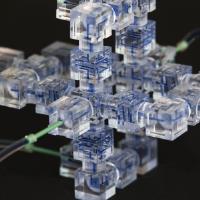 Add My Company
Add My Company
Sign In
Microfluidics Assembled in a Snap
11-05-2017

When electricity was discovered, scientists recognized a similarity between fluid in a pipe and electrons in a wire. Wire showed resistance to flow just as pipes do. Voltage in an electrical system was analogous to pressure in a fluidic system. Current was analogous to flow rate. Now, researchers at the University of Southern California, led by engineering professor Noah Malmstadt, are reversing the metaphor to standardize microfluidic design. They report their research in a recent issue of the Proceedings of the National Academy.
"We were inspired by the idea of standardization that you see with electrical parts," Malmstadt says. "We wanted to build a common platform for fluidic circuits, just like there is for electrical circuits."
Microfluidic devices are typically made by lithography. In a typical procedure, the channel design is etched into a silicon wafer, then polydimethylsiloxane (PDMS) is poured over the wafer. After hardening, the PDMS peels off with the imprinted design. A glass or plastic substrate can be adhered to the imprinted side of the PDMS to make waterproof channels.
Lithography often requires work in a clean room. However, as Malmstadt says, "Clean room work can be pretty miserable." In order to avoid the cost (and misery) of clean room work, the modules were fabricated by high-resolution stereolithography, a type of three-dimensional (3D) printing. After designing each module, the group sent the CAD specifications to an external company that did the fabrication. Though the team assembled complex designs with their modules, assembly never took longer than an hour and everything was done on the benchtop. The team never once stepped in a clean room. Amazingly, the devices worked the first time.
"In order for a device to work properly, all the different functional domains have to be just perfect, which is pretty rare," says Michael Roper, a professor at Florida State University, who fabricates microfluidic devices in his research but was not involved in this work. "If one small channel fails or one part of the device fails, your entire device is a no-go. It's pretty rare not to have to go back and do a redesign."
Malmstadt divided common microfluidic components into separate cubic modules with different design elements. He and his co-workers made junctions, splitters, and mixers along with unique elements such as input ports that split the flow for parallel applications and three-dimensional helices that mix two fluid streams. The cubes were standardized with 1 cm sides, 600 micrometer flow channels, and connection ports that jut out from the cube faces. Each port fits snuggly with another for snappy assembly.
To demonstrate their design philosophy, Malmstadt's team assembled a variety of devices. Emulsification modules were attached to a mixing circuit to form a range of droplet sizes at different rates. Optical sensors were added to the fabricated pieces to measure the size of the droplets while still inside of the device. The researchers coated the pre-fabricated channels with a fluoropolymer using initiated chemical vapor deposition to change the hydrophobicity of the inner walls. In their most impressive iteration, they assembled parallel three-dimensional fluidic channels for high-throughput applications, not possible with standard microfluidic designs which are almost exclusively planar.
Some systems were permanently sealed with epoxy to enhance their long-term stability, while others were disassembled and reused. Prepping the devices for reuse was simple. They ran water through the connected system, disassembled the blocks, and soaked the separated parts in alcohol. So long as the modules weren't damaged during disassembly, the reconnected joints didn't leak.
Malmstadt hopes his standardization and open-source library will make microfluidics a more prevalent research technique. "We're excited about the idea of an open design philosophy and enabling people who otherwise would be intimidated by working in a clean room to apply some of these simple design tools to their own microfluidic applications."
For more information on Microfluidics Assembled in a Snap talk to Testbourne Ltd
Enquire Now
List your company on FindTheNeedle.

